Scottish Social Attitudes Survey 2017: attitudes data
This survey provides an important source of data on attitudes to government, the economy and public services over this period.
This document is part of a collection
5. The economy, general standard of living and the National Health Service
The Scottish Social Attitudes ( SSA) Survey 2017 asked participants about:
- What the highest priority of the Scottish Government should be
- Perceived changes in the economy and in the general standard of living over the previous year
- Satisfaction with the way the National Health Service runs nowadays and perceived changes in standards in the health service over the previous year
In this chapter we present headline findings at a glance, and highlight statistically significant differences in views between different groups in the population.
What should be the Scottish Government's priority?
Figure 9 shows that when asked to choose what the Scottish Government's highest priority should be from a list, the four priorities selected most often were:
- improving standards of education (26%);
- help the economy grow faster (22%);
- improving people's health (19%);
- Improve housing (15%);
This is the first year that improving standards of education has been the most commonly selected priority for the Scottish Government ( Figure 9). From 2009 until 2016 helping the economy grow faster was people's highest priority for the Scottish Government. [23]
The percentage of people identifying cutting crime as the priority has fallen dramatically from 27% in 2007 to 6% in 2017.
Figure 9 What should be the Scottish Government's highest priority? (2017, %)
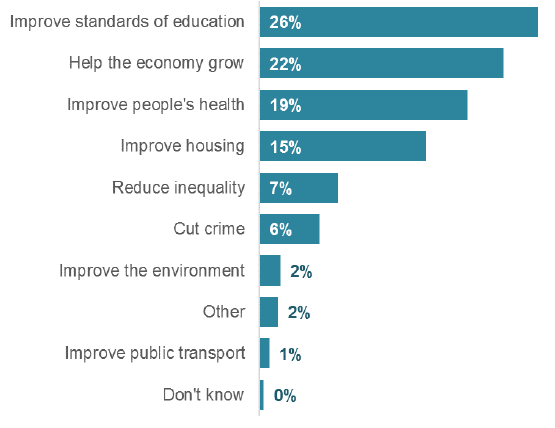
How has Scotland's economy changed over the last 12 months?
Half of people (50%) said that Scotland's economy had weakened 'a little' or 'a lot' in the past year. This compared with 54% in 2016. In 2017, the proportion of people who said that Scotland's economy had become 'a little' or 'a lot stronger' in the past year was 15%. This figure is the same as in 2016 (Figure 10).
Figure 10 Has Scotland's economy strengthened ('a lot' or 'a little') or weakened ('a lot' or 'a little') in the past 12 months? (2004-2017, %)
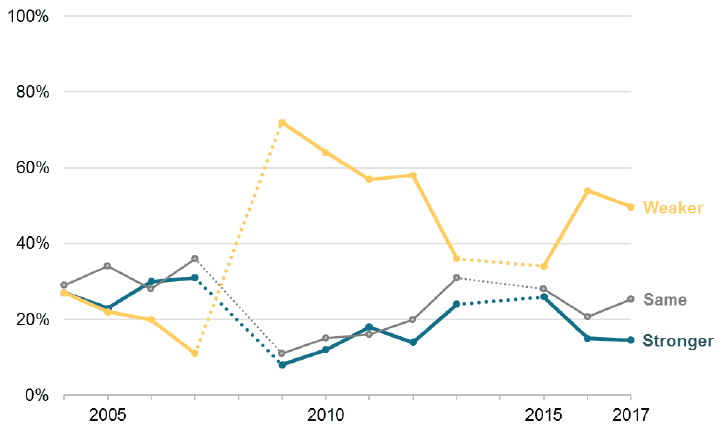
Perceived responsibility for changes
Of those who said the economy had weakened, 39% attributed this to UK Government policies, 29% attributed this to Scottish Government policies, and 15% to 'some other reason'.
Of those who said the economy had improved, 68% attributed this to Scottish Government policies, 10% to UK Government policies and 14% to 'some other reason'.
How has the general standard of living in Scotland changed over the last 12 months?
In 2017, 56% of people said the general standard of living had fallen 'a lot' or 'a little', 26% said it had 'stayed the same', and 14% of people said it had increased 'a lot' or 'a little' ( Figure 11).
Between 2011 and 2016, the percentage of people saying that the general standard of living had fallen in the past year had been declining. In 2017 this figure increased by 20 percentage points. The proportion of people who said that the standard of living had increased was 14% in 2017 compared to 19% in 2016 (Figure 11).
Figure 11 Has the general standard of living in Scotland increased ('a lot' or 'a little') or fallen ('a lot' or 'a little') in the past 12 months? (2004-2017, %)
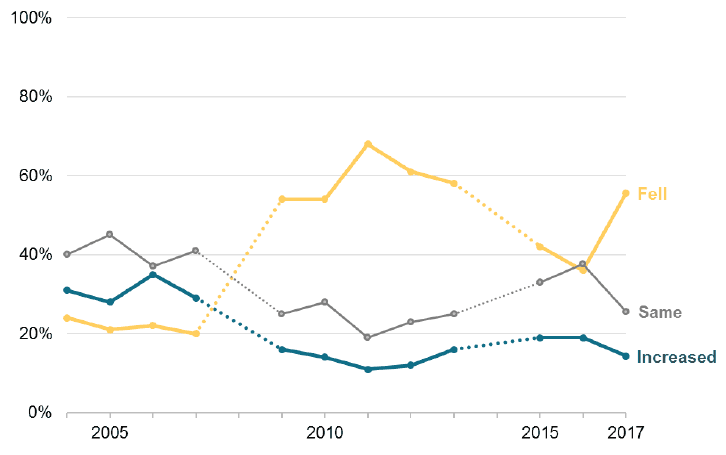
Perceived responsibility for changes
Of those who said the standard of living had worsened, 50% attributed this to UK Government policy, 16% attributed this to Scottish Government policy, and 14% to 'some other reason'.
Of those who said the standard of living had improved, 43% attributed this to Scottish Government policy, 28% to UK Government policy and 15% to 'some other reason'.
Variations in attitudes between subgroups: Economy & general standard of living
Views on changes to the economy, standards of living and standards in the health service had improved or declined varied between a number of social groups, based on statistical significance, and are listed here. Variables with no statistically significant differences are listed in Annex A.
Views on whether Scotland's economy had weakened varied by subgroup as follows [24] :
Scotland's economy had weakened by 'a little' or 'a lot'
| Subgroups | % |
|---|---|
| Interest in politics | |
| Any interest in politics | 52 |
| 'No interest at all' in politics | 28 |
| Support for a political party | |
| Supported or felt close to a political party | 52 |
| Didn't feel close to a particular party | 46 |
| Political affiliation | |
| SNP supporter | 42 |
| Other | 54 |
| Sex | |
| Female | 50 |
| Male | 49 |
| Tenure | |
| Home owners | 53 |
| Private renters | 46 |
| Social renters | 44 |
| Age | |
| 16-24 | 45 |
| 25-39 | 43 |
| 40-64 | 53 |
| 65+ | 55 |
| National identity | |
| More Scottish than British | 45 |
| Equally Scottish and British | 57 |
| More British than Scottish | 61 |
| Educational Qualification | |
| Degree or equivalent | 58 |
| No formal qualifications | 47 |
Views on whether living standards in Scotland had fallen varied by subgroup as follows [25] :
Living standards in Scotland had fallen by 'a little' or 'a lot'
| Subgroups | % |
|---|---|
| Age | |
| 16-24 | 31 |
| 25-39 | 52 |
| 40-64 | 63 |
| 65+ | 61 |
| Tenure | |
| Home owners | 59 |
| Private renters | 43 |
| Social renters | 58 |
| Economic Activity | |
| Education or full time training | 29 |
| In work or waiting to take up work | 55 |
| Unemployed | 56 |
| Retired | 61 |
| Support for a political party | |
| Supported or felt close to a political party | 59 |
| Didn't feel close to a particular party | 49 |
| Interest in politics | |
| Any interest in politics | 56 |
| 'No interest at all' in politics | 49 |
| Political Spectrum | |
| Right | 53 |
| Left | 60 |
| Political affiliation | |
| SNP supporter | 58 |
| Other | 54 |
| Living Comfortably | |
| Living comfortably on present income | 53 |
| Struggling on their present income | 69 |
| Main Income Source | |
| Wages or private income | 53 |
| State benefits | 67 |
National Health Service ( NHS)
People were asked two key questions on the National Health Service in Scotland:
- How satisfied or dissatisfied are you with the way the National Health Service runs nowadays?
- Has the standard of the health service in Scotland increased or fallen in the last 12 months?
How satisfied are you with the way the NHS runs?
In 2017, 55% of people reported that they were 'satisfied' or 'very satisfied' with the way the NHS runs nowadays. This compared with 60% in 2016. 30% of people said they were dissatisfied and 15% were neither satisfied or dissatisfied (Figure 12).
Figure 12 How satisfied or dissatisfied would you say you are with the way in which the National Health Service runs nowadays? (1999-2017, %)
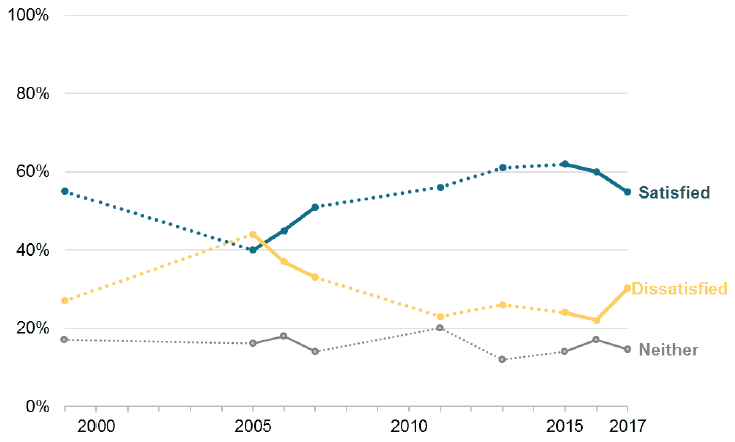
How has the standard of the health service in Scotland changed over the last 12 months?
In 2017, 49% of people said that standards in the health services had fallen 'a little' or 'a lot' in the past year. This compared with 37% in 2016. 36% of people said standards had stayed the same, 9% said they had increased 'a little' or 'a lot' (Figure 13).
Figure 13 Has the standard of the health service in Scotland increased or fallen in the past 12 months? (1999-2017, %)
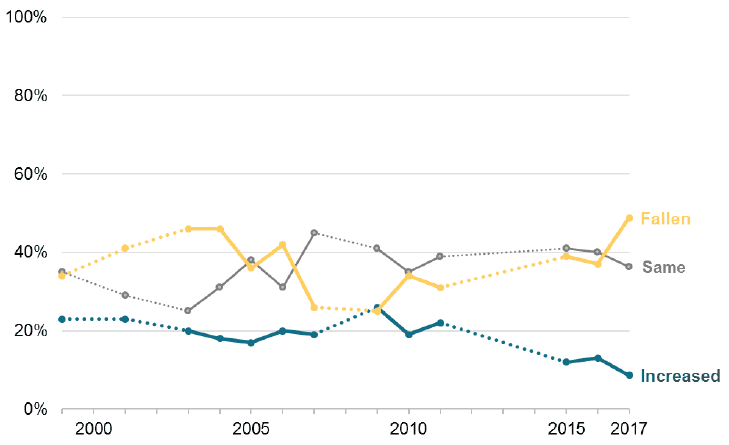
Perceived responsibility for changes
Of those who said standards in the NHS had fallen, 46% attributed this to UK Government policy, 27% attributed it to Scottish Government policy, and 13% to 'some other reason'.
Of those who said standards in the NHS had improved, 57% attributed this to Scottish Government policy, 16% to UK Government policy and 13% to 'some other reason'.
Variations in attitudes between subgroups: NHS
Satisfaction with, and views on whether standards in the health service had improved or declined varied between a number of social groups, based on statistical significance, and are listed here. Variables with no statistically significant differences are listed in Annex A.
Satisfaction with the way the health service is run varied by subgroup as follows [26] :
'Satisfied' or 'very satisfied' with the way the health service runs nowadays.
| Subgroups | % |
|---|---|
| Living Comfortably | |
| Living comfortably on present income | 60 |
| Struggling on their present income | 40 |
| Age | |
| 16-24 | 60 |
| 25-39 | 58 |
| 40-64 | 50 |
| 65+ | 58 |
| Self-reported Health | |
| Good health | 57 |
| Poor health | 43 |
| Political Spectrum | |
| Right | 68 |
| Left | 53 |
| Main Income Source | |
| Wages or private income | 57 |
| State benefits | 48 |
| Economic Activity | |
| Education or full time training | 70 |
| In work or waiting to take up work | 54 |
| Unemployed | 37 |
| Retired | 56 |
Views on whether the standards in the health service have fallen varied by subgroup as follows [27] :
Standards in the health service have fallen by 'a little' or 'a lot'
| Subgroups | % |
|---|---|
| Age | |
| 16-24 | 43 |
| 25-39 | 36 |
| 40-64 | 54 |
| 65+ | 57 |
| Main Income Source | |
| Wages or private income | 45 |
| State benefits | 62 |
| Self-reported Health | |
| Good health | 45 |
| Poor health | 65 |
| Children in Household | |
| No children | 53 |
| With children | 39 |
| Educational Qualification | |
| Degree or equivalent | 43 |
| No formal qualifications | 51 |
| Support for a political party | |
| Supported or felt close to a political party | 51 |
| Didn't feel close to a particular party | 45 |
| Political affiliation | |
| SNP supporter | 47 |
| Other | 50 |
| Tenure | |
| Home owners | 51 |
| Private renters | 41 |
| Social renters | 52 |
| Political Spectrum | |
| Right | 38 |
| Left | 53 |
Contact
There is a problem
Thanks for your feedback